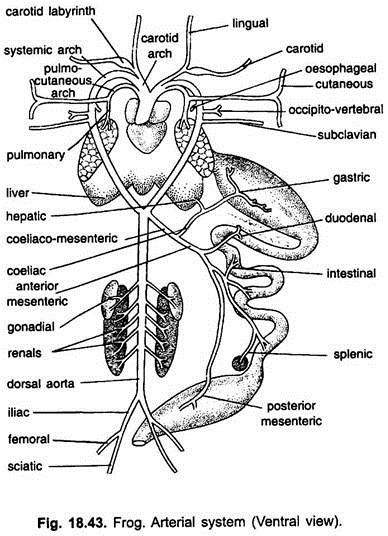The blood vessels which carry the blood away from the heart to different parts of the body constitute the arterial system. In frog arterial system begins with the truncus arteriosus which divides into two large right and left branches or trunks. Each branch divides into three aortic arches- an anterior carotid arch, a middle systemic arch and a posterior pulmocutaneous arch.
Carotid Arch:
The carotid arch of each side also divides into two, an external carotid or lingual going to the lower jaw and tongue and an internal carotid to the orbit and brain. Each internal carotid at its commencement bears a swollen carotid body or labyrinth formed from the second pair of gill-slit. Carotid bodies or labyrinths have a network of capillaries and chromoffin cells. They detect the pressure of oxygen and CO2 in the blood.
Systemic Arch:
The two systemic arches as pass outward and curve around the oesophagus to join to form a median dorsal aorta going backward beneath the vertebral column.
Each systemic arch gives out three arteries:
ADVERTISEMENTS:
(i) Oesophageal artery to the oesophagus,
(ii) Occipitovertebral artery to the head, vertebral column and spinal cord and
(iii) A large subclavian to the forelimbs.
The oesophageal artery very often arises from the occipitovertebral artery.
Pulmocutaneous Arch:
ADVERTISEMENTS:
Each pulmocutaneous arch divides into two arteries- a pulmonary artery going to a lung and a cutaneous artery to the skin and buccal cavity.
Dorsal Aorta:
It is an unpaired artery formed by the union of two systemic arches. It runs posteriorly mid-dorsally just beneath the vertebral column.
It gives off a number of arteries:
ADVERTISEMENTS:
(i) Coeliaco-Mesenteric Artery:
A large but unpaired coeliaco-mesenteric artery arises at the point where the dorsal aorta is formed by the union of the right and left systemic arteries. Coeliaco-mesenteric passing through the mesentery divides into two main branches- a small coeliac artery going to the stomach (gastric) and liver (hepatic) and a large anterior mesenteric sending branches to the duodenum (duodenal), spleen (splenic) and ileum (intestinal). From the anterior mesenteric artery arises an impaired posterior mesenteric artery going to the large intestine. It sometimes arises from the posterior end of dorsal aorta.
(ii) Gonadial:
A pair of small gonadial arteries to the gonads, called spermatic in male and ovarian in female.
(iii) Renal:
Dorsal aorta runs backward between the kidneys and gives off 5 to 6 pairs of renal arteries to both the kidneys.
(iv) Common Iliacs:
Posteriorly dorsal aorta divides into two large iliac arteries supplying the hindlimbs. Each iliac as it enters the leg gives off a branch which divides into an epigastric supplying the central body wall, and a recto-visceral artery to the rectum and bladder. A femoral artery to the skin and the muscles of the anterior part of the thigh and an iliac artery continues further as the sciatic artery going to the shank.
